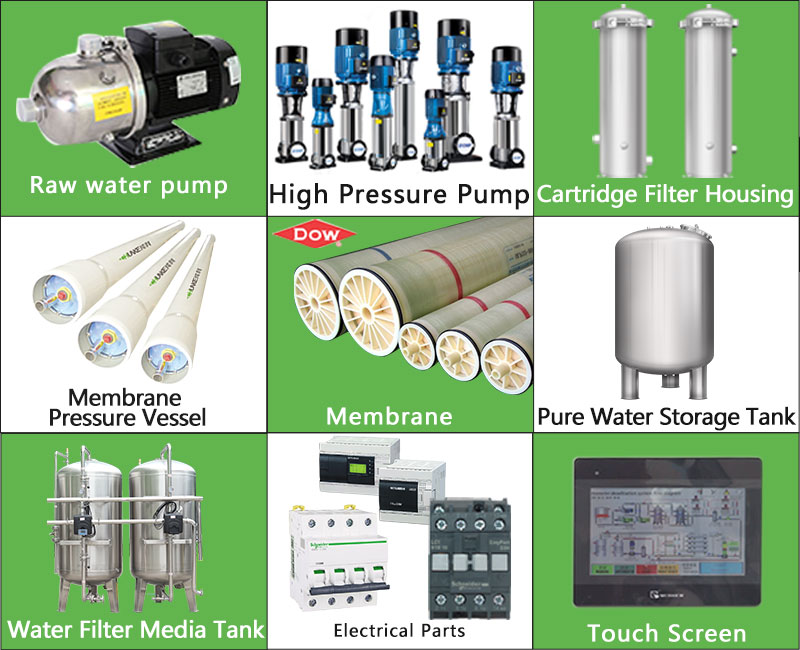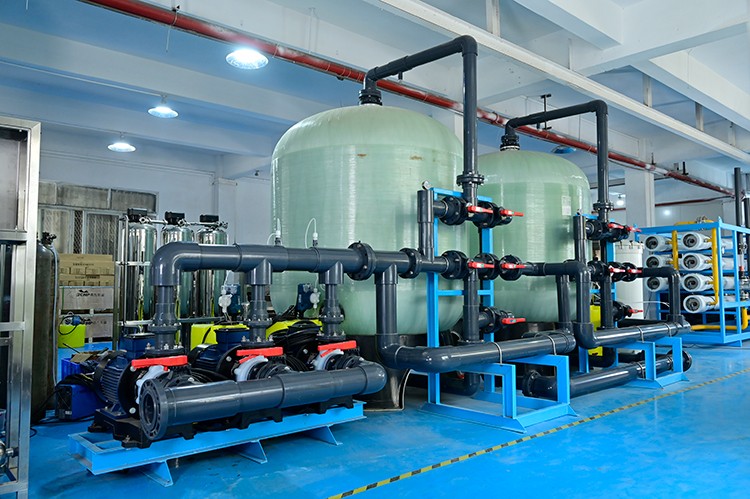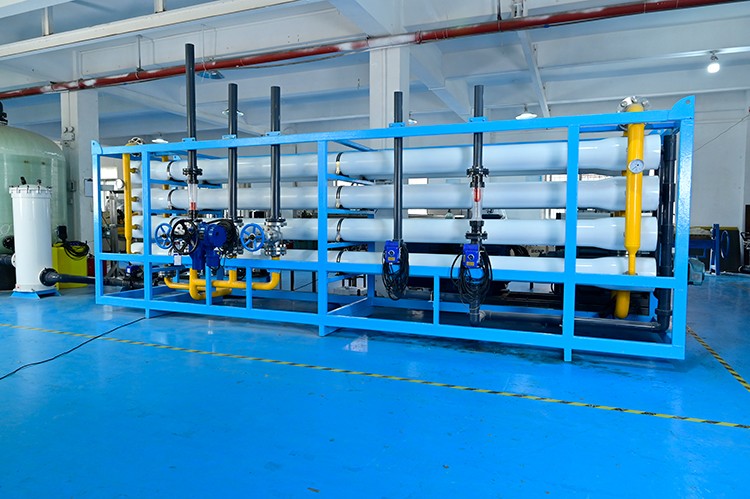What is the size of a 3000 liter/hour water treatment plant?
The capacity of a water treatment plant is an important indicator for evaluating its treatment capacity. It directly determines how much water the water treatment plant can treat to meet specific needs. Knowing how to calculate the capacity of a water treatment plant and further understanding the size of a 3000 liter/hour water treatment plant is crucial for practitioners in the water treatment industry and engineers in related fields.
This article will explore in detail the calculation method of water treatment plant capacity and analyze its size and practical application using a 3000 liter/hour water treatment plant as an example.

What is the capacity of a water treatment plant?
The capacity of a water treatment plant usually refers to the amount of water that the water treatment equipment can treat per unit time, usually expressed in liters/hour (L/h), cubic meters/hour (m³/h) or million gallons/day (MGD). This indicator reflects the maximum treatment capacity of a water treatment plant under its design conditions and is an important basis for the design and operation of water treatment facilities.
The capacity of a water treatment plant is affected by several factors, including:
● Water quality: The higher the degree of contamination of the raw water, the greater the complexity of the treatment process, which affects the treatment capacity.
● Treatment process: Different water treatment technologies (such as reverse osmosis, ultrafiltration, sedimentation, disinfection, etc.) have different requirements for water treatment speed and efficiency.
● Equipment efficiency: The performance, maintenance status and operating conditions of the equipment will affect the actual treatment capacity.
● Operating parameters: Operating conditions such as flow, pressure, temperature, etc. will also affect the capacity of the water treatment plant.

How to calculate the capacity of a water treatment plant?
To calculate the capacity of a water treatment plant, it is necessary to comprehensively consider the design parameters, process flow and actual operating conditions. The following are the main steps to calculate the capacity:
Determine the design flow
The design flow is the basis for calculating the capacity of a water treatment plant. The design flow is usually determined based on demand analysis, including factors such as water consumption, water supply range and water quality requirements. Taking 3000 liters/hour as an example, the design flow is 3000 liters/hour, or 3 cubic meters/hour.
Determine the treatment process and flow
The treatment process of a water treatment plant usually includes multiple steps, such as pretreatment (screening, sedimentation), primary treatment (reverse osmosis, ultrafiltration), post-treatment (disinfection, mineralization), etc. The treatment capacity of different process steps may be different, so the treatment capacity of each step needs to be considered comprehensively when calculating the capacity.
For example, if a water treatment plant uses multi-stage filtration, reverse osmosis and disinfection processes, the treatment capacity of each step may be as follows:
● Multi-stage filtration: 5 cubic meters/hour
● Reverse osmosis: 3 cubic meters/hour
● Disinfection: 4 cubic meters/hour
Since reverse osmosis is the bottleneck process and has the lowest treatment capacity, the actual capacity of the water treatment plant should be calculated as 3 cubic meters/hour.
Consider water loss and by-products
In actual operation, the water treatment process usually produces a certain amount of water loss or by-products. For example, the reverse osmosis system usually produces a certain proportion of concentrated water, which cannot be used as purified water. Therefore, this part of the loss needs to be considered when calculating the capacity.
Taking a 3000 liter/hour water treatment plant as an example, assuming that the water production rate of the reverse osmosis system is 75%, that is, for every 100 liters of raw water processed, 75 liters of purified water are finally produced. Then, the actual water purification capacity of the system is: 3000L/h×75%=2250L/h.
That is, 2250 liters of purified water can be produced per hour.
Equipment utilization and redundant design
In actual operation, equipment utilization and redundant design are also important factors affecting capacity. Equipment utilization refers to the actual operating capacity of the equipment under design conditions, which is usually less than 100%. Redundant design is the backup capacity set to cope with equipment maintenance, failure or peak demand.
For example, assuming that the equipment utilization rate is 90% and 10% redundant capacity is designed, the actual available processing capacity is: 2250L/h×90%×(1+10%)=2025L/h.
This means that although the design capacity is 3000 liters/hour, the actual available processing capacity is about 2025 liters/hour.

What is the size of a 3000 L/h water treatment plant?
A 3000 L/h water treatment plant is moderately sized and suitable for the water supply needs of small and medium-sized industrial users, small communities or large buildings. For example:
● Small industrial enterprises: Many small and medium-sized manufacturing enterprises require a stable supply of industrial water, and a 3000 L/h water treatment capacity is sufficient to meet their needs.
● Community water supply: For a small community or residential area, a 3000 L/h water treatment plant can provide daily drinking water, washing and irrigation water.
● Large buildings: Such as hotels, office buildings or shopping malls, etc., require high-quality water sources to meet the needs of their residents or users.
A 3000 L/h water treatment plant usually needs to be equipped with the following equipment:
● Pretreatment equipment: including screen filters, sedimentation tanks, etc., for removing large particle impurities and sediments.
● Main treatment equipment: such as reverse osmosis devices, ultrafiltration membrane components, etc., for deep purification of water quality.
● Post-treatment equipment: including ultraviolet disinfectors, activated carbon filters, etc., for further improving water quality and removing odors.
● Water tanks and piping systems: used to store and transport purified water.
In terms of floor space, a 3,000 liter/hour water treatment plant usually requires 50-100 square meters of space, depending on the equipment configuration and the complexity of the process flow.

What is the energy consumption and operating cost of a 3,000 liter/hour water treatment plant?
The energy consumption and operating cost of a water treatment plant are key factors in determining its economic feasibility. The main sources of energy consumption for a 3,000 liter/hour water treatment plant include:
● Pumping system: used to pressurize and transport water flow, and energy consumption is proportional to flow rate and pressure.
● Reverse osmosis system: Because high pressure is required to push water through the membrane, its energy consumption is relatively large.
● Other equipment: such as ultraviolet disinfection, dosing system, etc., have relatively small energy consumption.
Assuming that the energy consumption of the water treatment plant is 0.5 kWh/m3 of water treatment, the daily electricity consumption is: 0.5kWh/m3×3m3/h×24h=36kWh.
In addition, the operating costs also include the replacement of filter cartridges and membranes, equipment maintenance and staff wages.
Cost-effectiveness analysis
In order to evaluate the cost-effectiveness of a 3,000 liter/hour water treatment plant, it is necessary to comprehensively consider the construction cost, operating cost and output benefits. For example:
● Construction cost: including equipment procurement, installation and commissioning costs. The construction cost of a 3,000 liter/hour water treatment plant is usually between RMB 500,000 and RMB 1 million, depending on the specific configuration and regional differences.
● Operating cost: including electricity, filter cartridge replacement, maintenance and labor costs. Assuming the daily operating cost is RMB 200, the annual operating cost is about RMB 73,000.
● Output benefit: If the water treatment plant is used for commercial purposes, it can generate income by selling water or providing water treatment services. Assuming that the water treatment cost is 0.5 yuan/liter and the selling price is 1 yuan/liter, the daily net income is: (1 yuan/liter-0.5 yuan/liter) × 3000 liters = 1500 yuan. The annual income is about 547,500 yuan, and the net income after deducting the operating costs is about 474,500 yuan.




